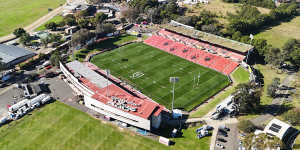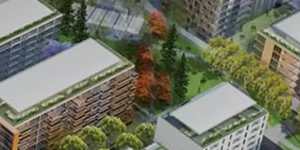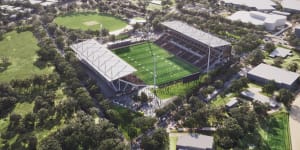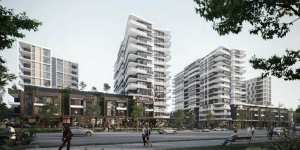SHMH,whose parent company is Shanghai-based and has completed at least one previous Sydney project,owns 7.8 hectares of land next to the stadium. It has plans,but as yet no approval,for 2000 units in towers up to 14 storeys,in what would be one of Sydney’s biggest housing propositions.

Penrith Stadium,which will be redeveloped in 2025,and behind it the SHMH site at 164 Station Street.Getty Images
The Labor state government last year ditched plans to completely rebuild Penrith (commercially known as BlueBet) Stadium on an adjacent site,opting instead for a $309 million refurbishment which will involve a new western grandstand and a significantly rebuilt eastern grandstand,with capacity increasing to 25,000.
The detailed plans went on exhibition in May and attracted only 11 submissions,which were published on Thursday. One was a fire-and-brimstone letter from SHMH – through consultant Tomasy Planning – to Planning Minister Paul Scully and his department alleging a “despicable” failure to consult it about the plans.
Tomasy’s principal,Denis Smith,said the government “must acknowledge that the community consultation process has failed abysmally to consult the applicant’s nearest neighbour”.
He claimed SHMH only found out about the stadium project upon receiving a letter from the department on May 24 and had never been invited to stakeholder forums or meetings,which commenced in December 2023.

An artist’s impression from a master plan produced by PTW for the SHMH Penrith project.Supplied
The stadium’s environmental impact statement (EIS),authored by consultants Ethos Urban,identified nine key stakeholders,including NSW Police,Venues NSW,Sydney Water,and Penrith Panthers. SHMH was not on that list.
It acknowledged the SHMH development was in its early stages but said that as no applications were currently lodged,the project could not be considered in the assessment.
“The failure to consult with SHMH4 Pty Ltd is considered to be a major flaw in the whole process
and could result in a legal challenge if the proposal were granted approval,” Smith wrote.
Among the company’s key concerns was a planned 14-metre increase in the height of the stadium grandstand,which Smith said would overshadow the proposed apartments across the street. They were also concerned about “future noise impacts on the occupants” and that stadium works may coincide with their own construction activity.

An artist’s impression of the new Penrith Stadium.NSW Government
But the stadium is expected to move quickly,closing after this year’s NRL season and reopening in 2026. SHMH has approval for earthworks and roadworks on its land,and has gone through a “design excellence” process,but it is yet to lodge its application for the residential development.
Smith also accused rival planning consultants Ethos Urban of having an “absurd” and “blatant” conflict of interest because it prepared the EIS for the stadium project while being the principal planning consultant for developer SHMH’s 2000 apartment project next door.

Both Ethos Urban and the government strongly denied any conflict of interest. Ethos Urban said it followed a robust “probity plan” regarding its work for the government,and the project team kept full confidentiality,even within the organisation. It also said it had ceased working on the SHMH Penrith project.
Infrastructure NSW,the government agency responsible for the stadium project,said in a statement it would meet SHMH and respond to its submission. SHMH did not respond to requests for comment,and Smith did not return calls and messages.
The developer has completed one other Sydney project,in Eastwood,and sold out of another site in Elizabeth Bay it had planned to redevelop.

An artist’s impression of the 2000 apartment development that could be built opposite the stadium.Supplied
If built,the 2000 apartments opposite the stadium would represent nearly a quarter of Penrith City Council’s 2029 housing target of 8400 new homes,recently set by the state government.
But the 78,000 square metre site has been plagued by trouble for nearly 20 years. Formerly home to a Panasonic television factory,it has been largely dormant since the plant closed in 2006. A previous owner-developer slashed the number of apartments it wanted to build from 1100 to 570 and added a hardware store to the mix,which the council rejected. Property records show SHMH then purchased the site for $45 million in 2015.